Artillery and Armour in the USA: Connecticut (1)
Artillery, Tanks and Armoured Fighting Vehicles in Connecticut (Part 1)
One of the aims of this website is to locate, identify and document every historical piece of artillery and all armoured fighting vehicles preserved in New England. Many contributors have assisted in the hunt for these tangible pieces of our military history and the list you see here is constantly being revised as new finds are discovered and the data is updated. The photos have come from various contributors, but the author likes to "ground truth" the reports, so a good number of the photos are by the author unless otherwise credited. Any errors found here are by the author. It often happens that military monuments that are relatively mobile, have been moved for restoration or scrapped. Sometimes they are repainted with different markings and serial numbers, or they are replaced with a different piece of kit. For those reasons, any additions, deletions, corrections or amendments that you may be able to add to this list of Artillery and AFVs in New England would be most welcome and may be e-mailed to the author at [email protected]. The primary aim is preserve our military history and to keep the record accurate.
Ansonia


(David Pelland Photos)
4.2-inch 30-pounder Parrot Rifle, 1861, No. 1 of 4 mounted on an iron stand at the base of the Soldier's Monument (mounted upside down), Pine Grove Cemetery.
4.2-inch 30-pounder Parrot Rifle, 1861, No. 2 of 4 mounted on an iron stand at the base of the Soldier's Monument, Pine Grove Cemetery.
4.2-inch 30-pounder Parrot Rifle, 1861, No. 3 of 4 mounted on an iron stand at the base of the Soldier's Monument, Pine Grove Cemetery, Pine Grove Cemetery.
4.2-inch 30-pounder Parrot Rifle, 1861, No. 4 of 4 mounted on an iron stand at the base of the Soldier's Monument, Pine Grove Cemetery.

(Author Photo)
QF 4.7-inch Mk. IV Armstrong Gun, Serial No. 11856 on a Central Pivot Mount Mk. 1, Serial No. 10842 was emplaced at Battery Drum, Fort Strong, Massachusetts. This gun is currently on display at the State Armory, Main Street, Ansonia, Connecticut. It may be similar to this one found at Fort Peninsula at Forillon National Park in Quebec.
Bantam

(David K. Leff Photo)
57-mm M1A1 Anti-tank Gun, Bantam Borough Hall.
Berlin

(Dave Pelland Photos)
3-inch M5 Anti-tank Gun, American Legion Post.

(neoc1 Photo)
3-inch Ordnance Rifle, Model 1861, set in concrete, weight ca 820 lbs, from the Civil War, flanked by two pyramids of cannon balls. It is mounted in front of the Soldiers Monument located at 312 Percival Avenue in the Kensington section of Berlin. The monument is reported to have been the first of its kind in the four New England states of Connecticut, Massachusetts, New Hampshire, and Maine, having been dedicated on 28 July 1863, with the 3-inch Ordnance Rifle added on 23 July 1913.
Bozrah

(Army Heritage and Education Center Photo)
8-mm Hotchkiss Model 1914 Machine Gun being operated on a range near Froissy, Oise, France, by a US Army Machine Gun Team from Company 1, 2nd Brigade, Machine Gun Battalion, 1st Division, 10 May 1918.

(Dave Pelland Photo)
Two 8-mm Hotchkiss Model 1914 Machine Guns, mounted on tripod stands flanking the war memorial. The American Expeditionary Forces (AEF) in France purchased 7,000 Mle 1914 Hotchkiss machine guns in 8-mm Lebel, and used them extensively at the front in 1917 and 1918.
Brandford


(GA Caher Photos)
M114 Command and Reconnaissance Carrier on public display at the Battery A, Connecticut National Guard Armory, 87 Montowese St.
Bridgeport

(MKGI Photo)
57-mm 45 calibre QF 6 pounder Hotchkiss Mark I, U.S. Navy, similar to the one in this Photo. These guns were manufactured in Bridgeport.


(David Pelland Photos)
Bronze 18-pounder smoothbore muzzle-loading Gun with Dolphin carrying handles, mounted on an iron stand facing the water at Seaside Park. It was cast in Seville, Spain on 13 December 1794, according to a date inscribed near the cannon’s neck. This gun was captured from a Spanish warship and is mounted in Bridgeport’s Seaside Park to honour the service of local residents during the Spanish-American War. The bronze gun faces southeast into Long Island Sound.
Bristol

German First World War 10-cm Kanone 04 (10-cm K 04) Field Gun, being examined by Sir Edward Kemp, following its capture during the Allied advance East of Arras, France, 1918. (Library and Archives Canada Photo, MIKAN No. 3397930)

(Dave Pelland Photo)
German First World War 10-cm Kanone 04 (10-cm K 04) Field Gun, standing at the WWI Memorial. It was the second heavy gun with modern recoil system accepted by the German Army. Although the standard version lacked a gunshield, some models, such as the 10 cm K 04/12, were fitted with a special gunshield and some other minor modifications. There was only 32 in service at the outbreak of the war. It could be transported in one load by a team of six horses, or it could be broken down into 2 loads (tandem hitches) for crossing rough terrain.
Canaan

(Author Photo)
M41A3 Walker Bulldog Tank (Serial No. 1964, RN 30183222, VFW Post 6851, S Canaan Rd (US 7). Similar to this one preserved in the 1st Cavalry Museum, Fort Hood, Texas.
Cannondale

(Civil War Archive Photo)

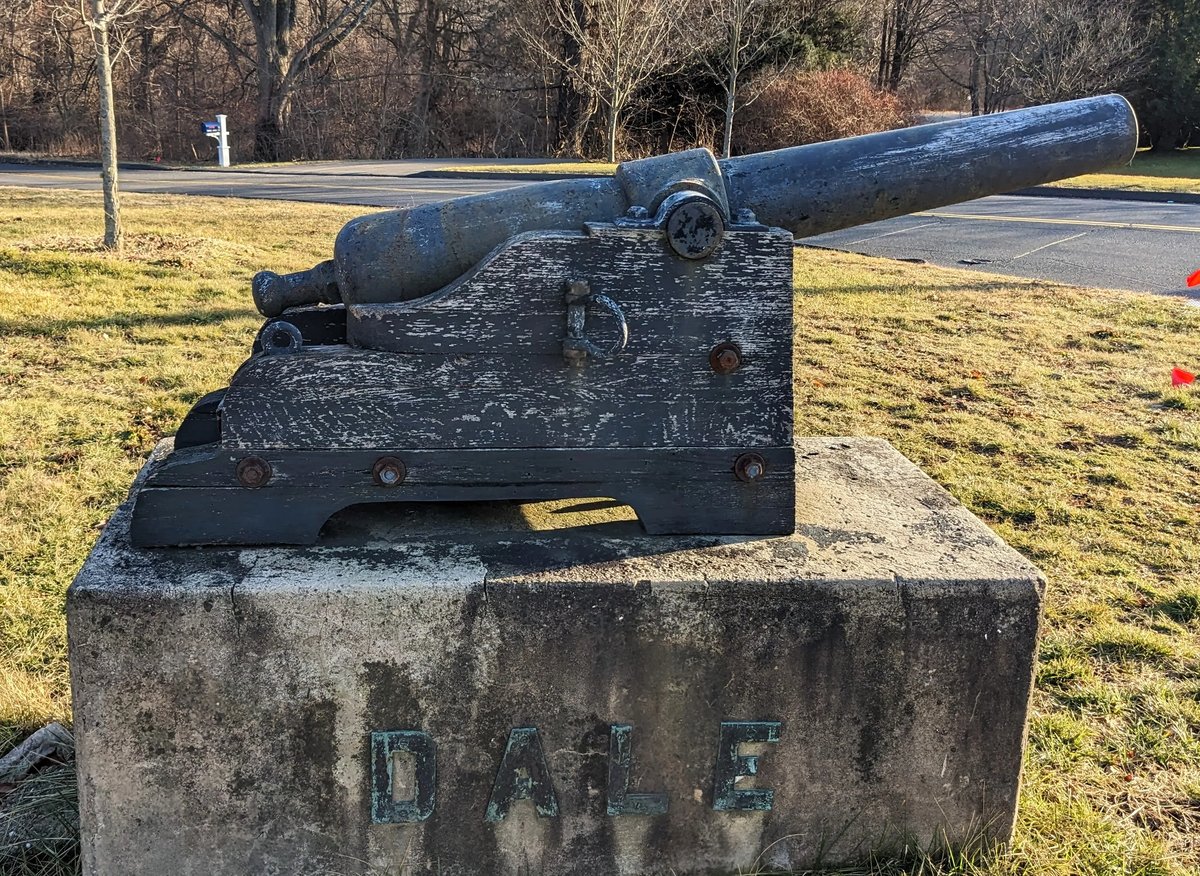




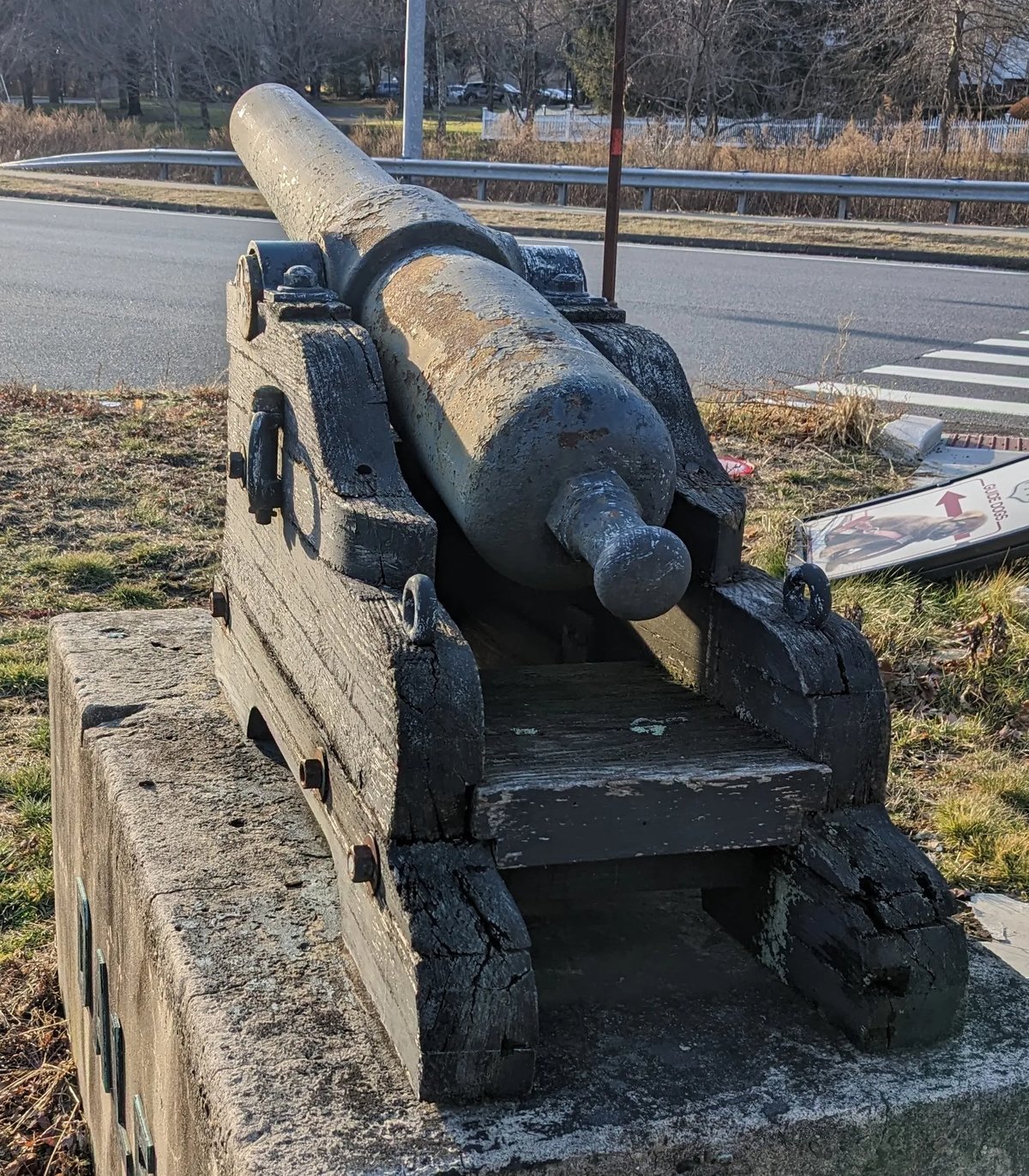
(Valerie Bueti Photos)
Possibly a 12-pounder (3.5-inch) Blakely rifle or Blakely gun.
Cannondale Connecticut was previously named Canaan, CT but they changed the name to Cannondale in 1915 because people kept confusing it with the other New Canaan CT. Samuel Miller took it upon himself to institute changing the town's name. To commemorate the occasion, Millier acquired the this cannon to put in the middle of town and named it "Dale". Cannondale CT is also where famous bicycles are made. The cannon was used in the Battle of Galveston. It was later shipped to Connecticut from Texas. (Valerie Bueti)
The Blakely rifle or gun is the name of a series of rifled muzzle-loading cannon designed by British army officer Captain Theophilus Alexander Blakely in the 1850s and 1860s. Blakely was a pioneer in the banding and rifling of cannon but the British army declined to use Blakely's design. The guns were mostly sold to Russia and the Confederacy during the American Civil War. Blakely rifles were imported by the Confederacy in larger numbers than other Imported English cannon. The State of Massachusetts bought eight 9 in (23 cm) and four 11 in (28 cm) models.
Blakely rifles had innovative design features using two layer construction and layers of rings which allowed rifling of larger cannons. Blakely's manufacturing innovations allowed larger guns of lighter weight and greater resistance to explosion. The Confederacy used the Blakely rifles in seacoast fortifications, fortifications at Vicksburg, as naval guns and, in the smaller sizes, as artillery in land battles.
Canton

(Town of Canton Photo)

(Dan R Photo)
4.7-inch Gun M1906 Field Gun, Canton Veterans Memorial.
Clinton

(Dave Pelland Photo)

(Johnna Kaplan Photo)

(YoSam Photo)
Cast-iron 6-pounder smoothbore muzzle-loading Gun mounted on a wood naval gun carriage, near the Civil War memorial.

(Casey Bell Photo)
Cast-iron 12-pounder smoothbore muzzle-loading Carronade with Blomefield pattern breeching ring mounted on a wood stand, next to the beach on Waterside Lane.
This gun was used in the war of 1776, and was taken by John Paul Jones from an English privateer in the English Channel, and sold to an English merchantman, who put it on board his brig and sailed for this country. The brig was wrecked on Saybrook Bar, and the wreckage was sold to the lighthouse keeper, Mr. Crane who in turn sold it to Captain James Farnham of Waterside Lane, Clinton (Killingworth). The gun was later used by residents of Clinton, (Killingworth) in repelling this attack of the British frigate in 1812. It was mounted on the Green at the foot of Waterside lane and shot so successfully as to cause the British to withdraw from the Harbor after firing a few shots ashore and into town.
Collinsville

(David K. Leff Photo)
4.7-inch M1906 Field Gun, cast at the Watervliet Armory, New York, on display by the town war memorial.
Cornwall Hollow



(David Pelland Photos)
24-pounder Model 1839 Siege Gun, RLB No. 4 on the muzzle. This gun may have been rebored as a 48-pdr James rifle. The gun stands on a granite base with a bronze eagle on its south face and wreaths on the east and west faces. The monument’s base has six pyramids of concrete cannonballs. The gun and monument are located at the intersection of Cornwall Hollow Road (Route 43) and Hautboy Hill Road.
Coventry





(David Pelland Photos)
4.2-inch 30-pounder Parrot Rifle, mounted on a granite base. This Parrott Rifle was forged in 1862 at the West Point Foundry in Cold Spring, New York. A dedication on the east face of the monument’s base reads, “Veterans, 1861-1865.” Next to the cannon is a triangular metal bracket that once held a pyramid of shells for the cannon. The fate of the shells is not recorded, but many Civil War cannonballs and shells were removed from monuments during World War II and donated to scrap metal drives.
Coventry


(Dave Pelland Photos)
Model 1893 Breech-loading Gun (Serial No. 15), 1896, Rock Island Arsenal, Illinois, mounted on a wheeled gun carriage, Veteran's Memorial Green.
Danbury, Military Museum of Southern New England
The U.S. Military Museum opened in 1995 as a not-for-profit organization dedicated to the preservation of American military history. The original intent of the museum was to maintain the memory of American Tank Destroyer units of the Second World War. Over the museum's 20 year history, thanks to generous donations and the hard work of many unpaid volunteers, the museum's collection has expanded to over 10,000 artifacts, covering all of the armed forces of the United States. The museum currently displays a wide cross-section of weapons and materials pertaining to 20th century American military history. Many of the museum's vehicles are extremely rare, and a few may be the only examples preserved in the Western Hemisphere. The museum staff is composed primarily of unpaid volunteers who are responsible for designing and installing exhibits, running the gift shop, and participating in public events.
The Exhibits include the following tanks, armoured fighting vehicles and artillery:

(Author Photo)
37-mm M3A1 Anti-tank Gun. Similar to this one in the National Museum of WWII, New Orleans, Louisiana.

(US Army Photo)
57-mm M1A1 AT Gun firing at a German bunker near Saint-Malo, Brittany in France, 31 July 1944.
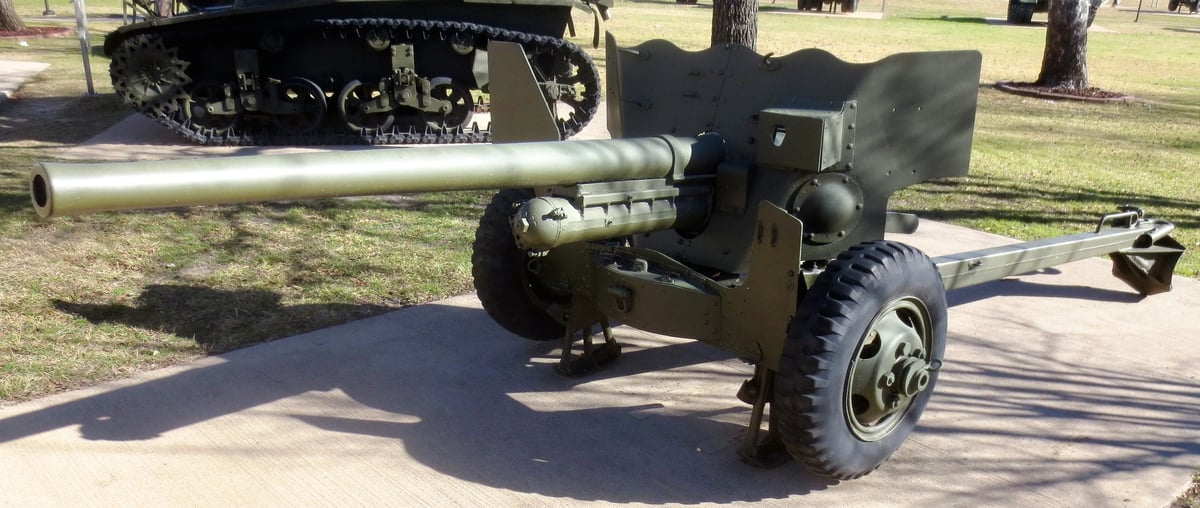
(Author Photo)
57-mm M1A1 Anti-tank Gun. Similar to this one on display at the 3rd Armored Cavalry Regiment Museum, Fort Hood, Texas.

(Author Photo)
3-inch M5 Anti-tank Gun. Similar to this one with the Louisiana National Guard Museum, New Orleans, Lousiana.

(US Army Photo)
M116 Husky Tracked Amphibious Cargo Carrier.
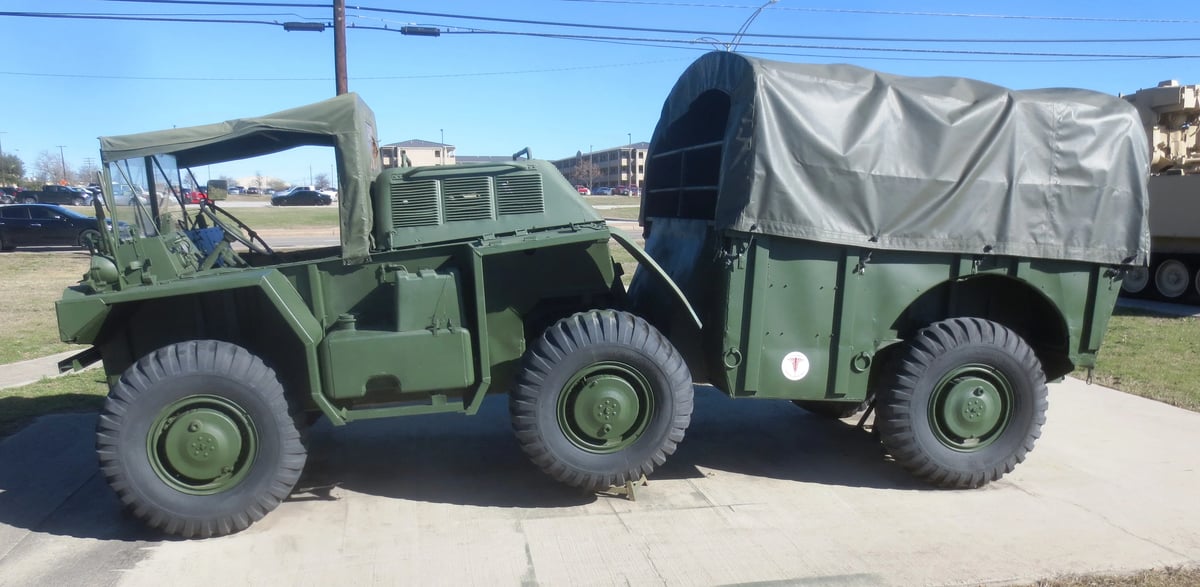
(Author Photo)
M-792 Gamma Goat Ambulance. Similar to this one on display at the 1st Armored Cavalry Division Museum, Fort Hood, Texas.

(S. Filatov Photo)
Soviet BA-64 Light Armoured Car, similar to this BA-64B on display at Nizhniy Novgorod Kremlin, Russia. The BA-64 on exhibit was captured in Korea by the soldiers of the 24th Infantry Division and returned to the United States for evaluation.

(Author Photo)
German Spahpanzer Luchs (Lynx). Similar to this one photographed by the author while serving with SFOR in Sarajevo, Bosnia-Herzegovina in 1997.

(Huhu Photo)
German Schutzenpanzer 12-3 APC. Similar to this one in the Bundeswehr Museum, Germany.
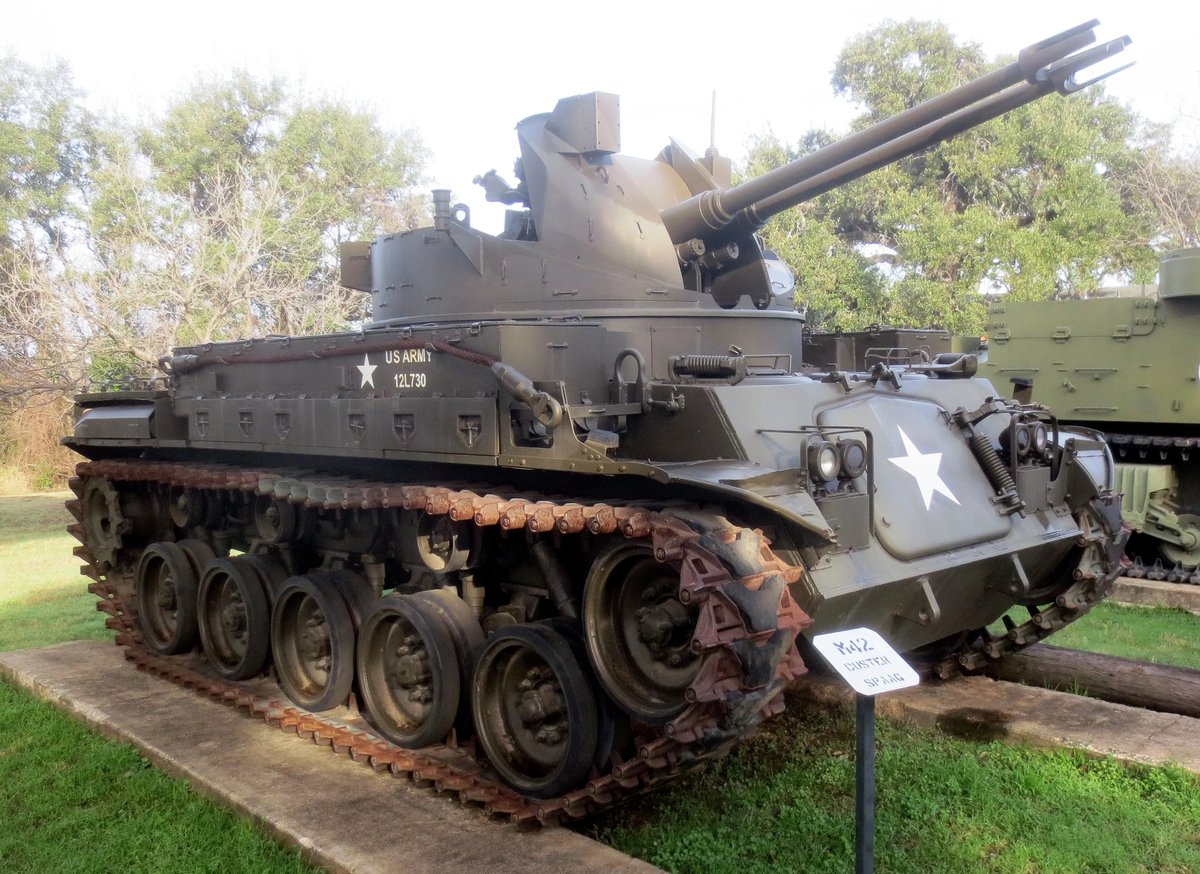
(Author Photo)
M42A1 Motor Gun Carriage, Duster, twin Bofors 40-mm cannon. Similar to this one on display at Camp Mabry, Austin, Texas.

(Author Photo)
M551 Sheridan Light Tank. Similar to this one on display at the Oshawa Military Museum, Ontario

(Jorchr Photo)
Swedish Panzarbandvagn 302 Armoured Personnel Carrier (APC).

(USN Photo)
5-inch 54-calibre Anti-Aircraft Gun, similar to this 127-mm/54 Mark 16 gun aboard the USN aircraft carrier USS Midway (CVA-41). The museum's 5"/54 doesn’t have the variable protective shield housing, so all of its features can be seen.

(Author Photo)
Centurion Mk. 5 Main Battle Tank (MBT), manufactured in the late 1950s and donated by the Swiss government after being deactivated in May 1993. It is similar to this one on display at the New Brunswick Military History Museum, 5 Canadian Division Support Group Base Gagetown, New Brunswick.

(Author Photo)
M108 105-mm Self Propelled Howitzer. Similar to this one with the Texas Military Forces Museum, Camp Mabry, Texas.

(Max Smith Photo)
M22 Locust Light Tank. Similar to this one on display in the Bovington Tank Museum, England.


(Author Photo)
M18 Hellcat Tank Destroyer. Similar to this one on display at the 3rd Armored Cavalry Regiment Museum, Fort Hood, Texas.

M36 Tank Destroyers in NW Europe during the Second World War. (US Army Photo)

(Author Photos)
M36 Tank Destroyer. Similar to this M36B1 on display at the 3rd Armored Cavalry Regiment Museum, Fort Hood, Texas.
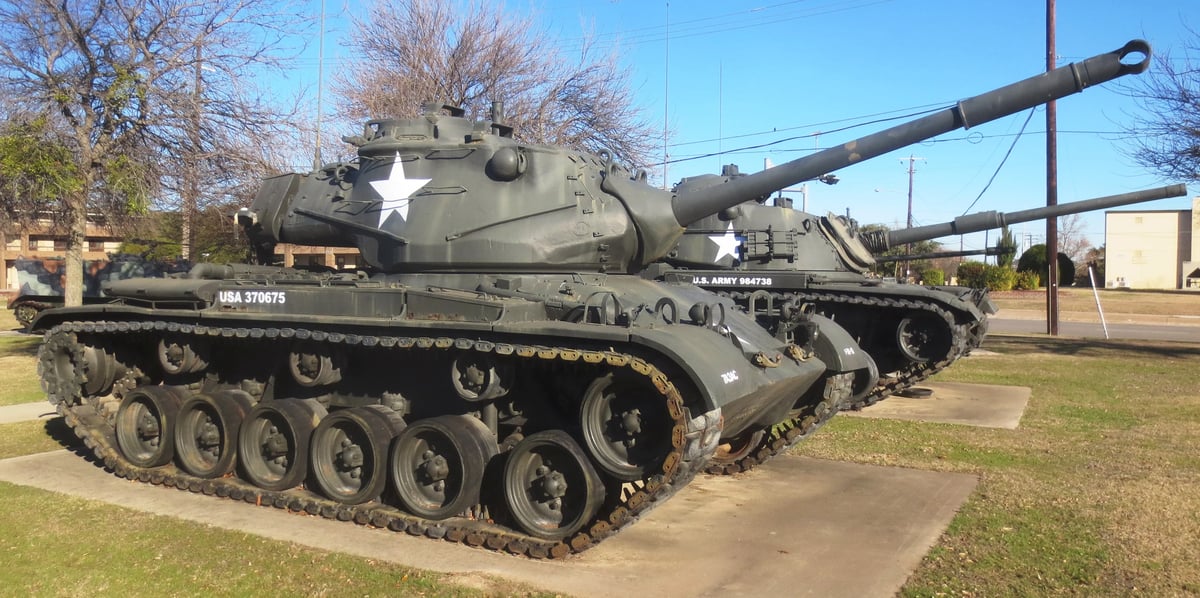
(Author Photo)
M47 Patton Medium Tank with 90-mm gun. Similar to this one on display at the 3rd Armored Cavalry Regiment Museum, Fort Hood, Texas.
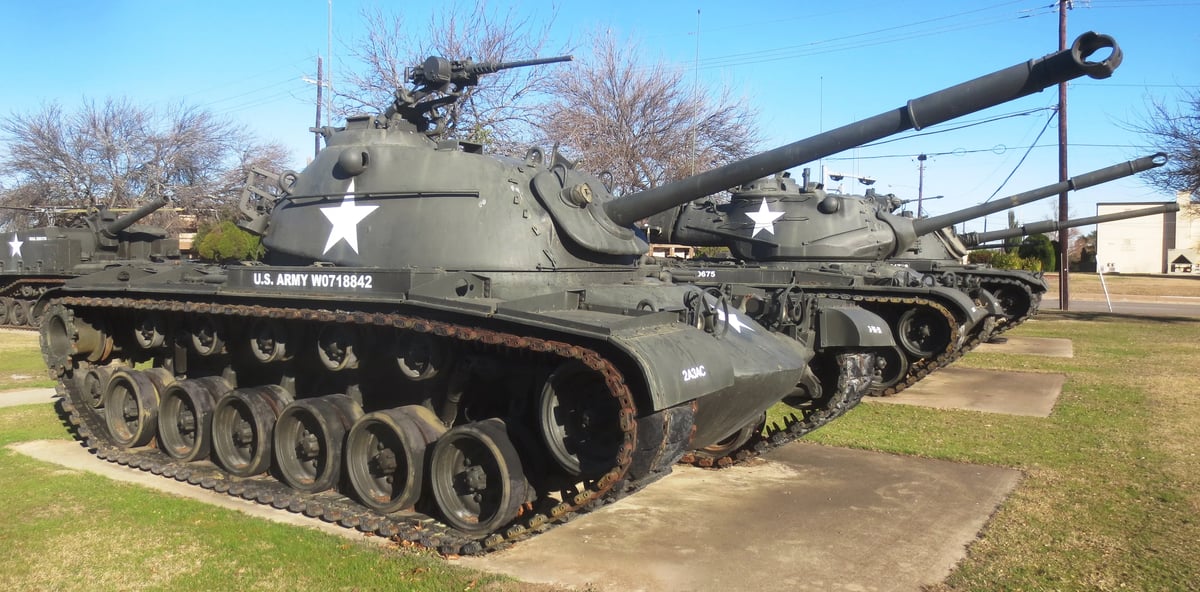
(Author Photo)
M48A1 Medium Tank with 90-mm gun. Similar to this one on display at the 3rd Cavalry Regiment Museum, Fort Hood, Texas.

(Author Photos)
M60A1 Medium Tank. Similar to this one on display at the 1st Armored Cavalry Division Museum, Fort Hood, Texas.

(Raymond Douglas Veydt Photo)
MBT-70 tank at Aberdeen Proving Ground, Maryland.

(Zukkor Photo)
MBT-70 at the Military Museum of Southern New England in Danbury, Connecticut.

(Author Photo)
Russian T-72 Main Battle Tank, 120-mm main gun. The T-72 is a Soviet second-generation main battle tank that entered production in 1971. About 20,000 T-72 tanks were built, making it one of the most widely produced post-Second World War tanks, second only to the T-54/55 family. The T-72 was widely exported and saw service in 40 countries and in numerous conflicts. Improved variants are still being built for export customers. Similar to this one with the New Brunswick Military History Museum, 5 Canadian Division Support Group Base Gagetown, New Brunswick.

(US Army Photo)
M2A1 Half-track on maneuvers at Fort Benning, Georgia, 1942. The M2 had a shorter hull compared to the M3 Half-tracks (left and background) and was equipped with hinged doors for ammunition compartments in the side armour.
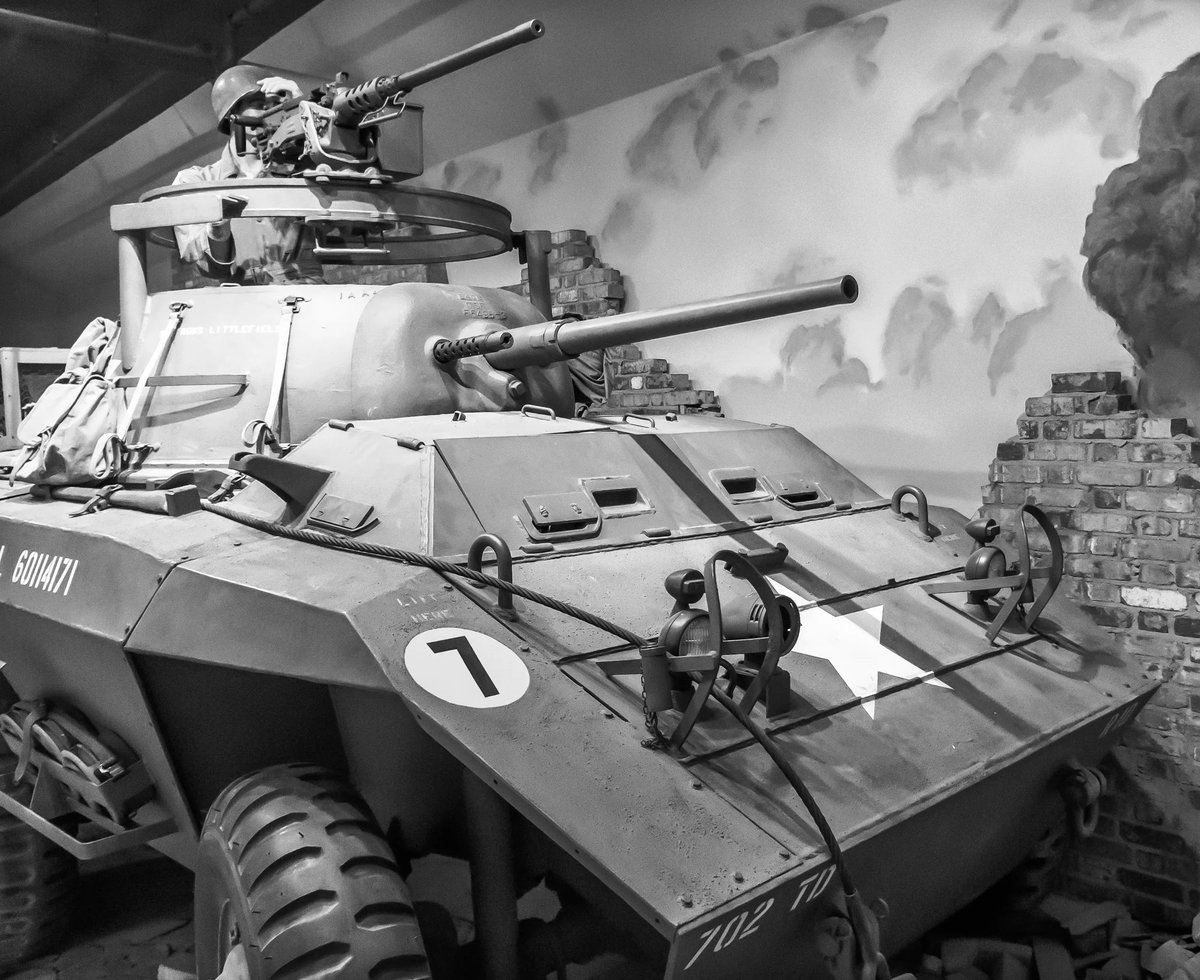
(Howard Dale Photo)
M20 Light Armoured Scout Car.
The M20 was an M8 Greyhound with the turret replaced with a low, armored open-topped superstructure and an anti-aircraft ring mount for a .50-in M2 heavy machine gun. A bazooka was provided for the crew to compensate for its lack of anti-armour weaponry. The M20 was primarily used as a command vehicle and for forward reconnaissance, but many vehicles also served as armoured personnel carriers and cargo carriers. It offered high speed and excellent mobility, along with a degree of protection against small arms fire and shrapnel. When employed in the command and control role, the M20 was fitted with additional radio equipment.

(Saiga20 K Photo)
122-mm Main Gun, used on the IS-2 Joseph Stalin D25-T similar to this one in the Kubinka Tank Museum, Russia.

(Author Photo)
M110A1 8-inch Self Propelled Howitzer. Similar to this one with the Texas Military Forces Museum, Camp Mabry, Texas.

(Author Photo)
M578 Armoured Recovery Vehicle (ARV). Similar to this one with the Texas Military Forces Museum, Camp Mabry, Texas.

(Author Photo)
M40A1 106-mm Recoilless Rifle. Similar to this one held in the New Brunswick Military History Museum, 5 Canadian Division Support Base Gagetown, New Brunswick.

(Bukvoed Photo)
Chinese Type 65 twin 37-mm Anti-Aircraft Gun, on a wheeled M1939 (61-K) gun mount. This piece was captured by the 1st Marine Division during Desert Storm in 1991, when Kuwait was being liberated. Similar this one with the Muzeyon Heyl ha-Avir, Hatzerim, Israel.

(Author Photo)
BMP-1 Infantry Fighting Vehicle. Similar to this one on display at the 3rd Cavalry Regiment Museum, Fort Hood, Texas.

(Bundeswehrmuseum Dresden Photo)
French Hotchkiss SP lA Armoured Reconnaissance Vehicle. Similar to this one in the Dresden Tank Museum, Germany.

(Bundeswehrmuseum Dresden Photo)
French Hotchkiss SPZ Observation Vehicle. Similar to this one in the Dresden Tank Museum, Germany.
German Schutzenpanzer 42-1 Cargo Carrier.

(Huhu Photo)
German SPZ Schutzen Panzer Mortar Carrier. Similar to this one in the Dresden Tank Museum, Germany.
Test Reconnaissance Vehicle with twin rocket launchers mounted on an experimental turret.
M-52 5-ton 6 X 6 Tractor Truck.

(USN Photo)
Model M-656 Cargo Truck.
Corbitt 50 SD6 5-ton truck.

(Rept0n1x Photo)
M886 Dodge Ambulance.
Clarktor 6 Airport tug.

(Ryan Crierie Photo)
M-274 Mule. Similar to this M274 Mechanical Mule with a M40 recoilless rifle at the American Armoured Foundation Museum.

(US Army Photo)
M39 APC. Similar to this US Army M39 assisting the USMC in Korea, 25 July 1953.

(Bukvoed Photo)
British FV 603 Saracen APC. Similar to this one in the Yad la-Shiryon Museum, Israel.

(USMC Photo)
105-mm M101A1 Howitzer.

(Author Photo)
155-mm M114 Howitzer. Similar to this one on display in Minto, New Brunswick.

(Ebyabe Photo)
5"/38 caliber Mk. 12 Anti Aircraft Gun. Similar to this one at Flagler Park, Okeechobee, Florida.
Danielson

(Dave Pelland Photo)
4.2-inch 30-pounder Parrot Rifle, Davis Park.
Derby

German First World War 15-cm sFH 13 Field Gun, captured by Canadians, Farbus Village, France, April 1971. (Library and Archives Canada Photo, MIKAN No. 3521832)

(David Pelland Photo)
German First World War 15-cm schwere Feldhaubitze 16 (15 cm sFH 13), Heavy Field Gun, Veterans Memorial Building, 1 Atwater Avenue.

(Metals - Conserve Art Photo)
4.2-inch 30-pounder Parrot Rifles, Serial Nos. 32, 34, 35 and 40, weight 4,200 lbs, cast at the West Point Foundry in 1861, mounted on an iron cradle, on the town common. Restoration work is underway and these guns will be repositioned to point upward, cleaned, and then treated with a corrosion converter and protective coating. One of the guns has a long dent in the barrel and a spherical dent near the firing chamber, likely caused by a counter-battery cannonball.
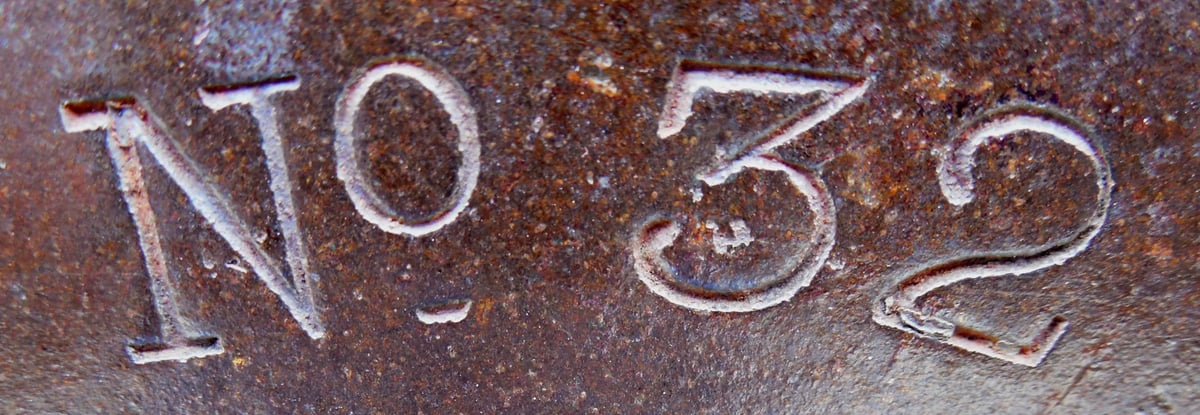

(Metals - Conserve Art Photos)
4.2-inch 30-pounder Parrot Rifle, No. 32, 1861, weight 4,200 lbs, 1861, mounted on an iron cradle, on the town common.


(Dave Pelland Photos)
4.2-inch 30-pounder Parrot Rifles, 1861, weight 4,200 lbs, 1861, mounted on an iron cradle, on the town common.
East Hartford

(Geocaching Photo)
Newton 6-inch trench mortar, behind the Zebulon Bidwell monument, in a small park at the corner of Tolland and Bidwell Streets. This mortar was designed by the British but produced by both the British and USA, and used by both in the First World War.

(US Army Photo)
US Army soldier loading a Newton 6-inch trench mortar during the First World War, ca 1918.

(David Pelland Photo)
Cast-iron 8-inch smoothbore muzzle-loading Siege Howitzer, with the Soldier's Monument. The gun and a stack of cannonballs appear near the northwest corner of the monument. The gun’s markings are covered by paint.
East Haven

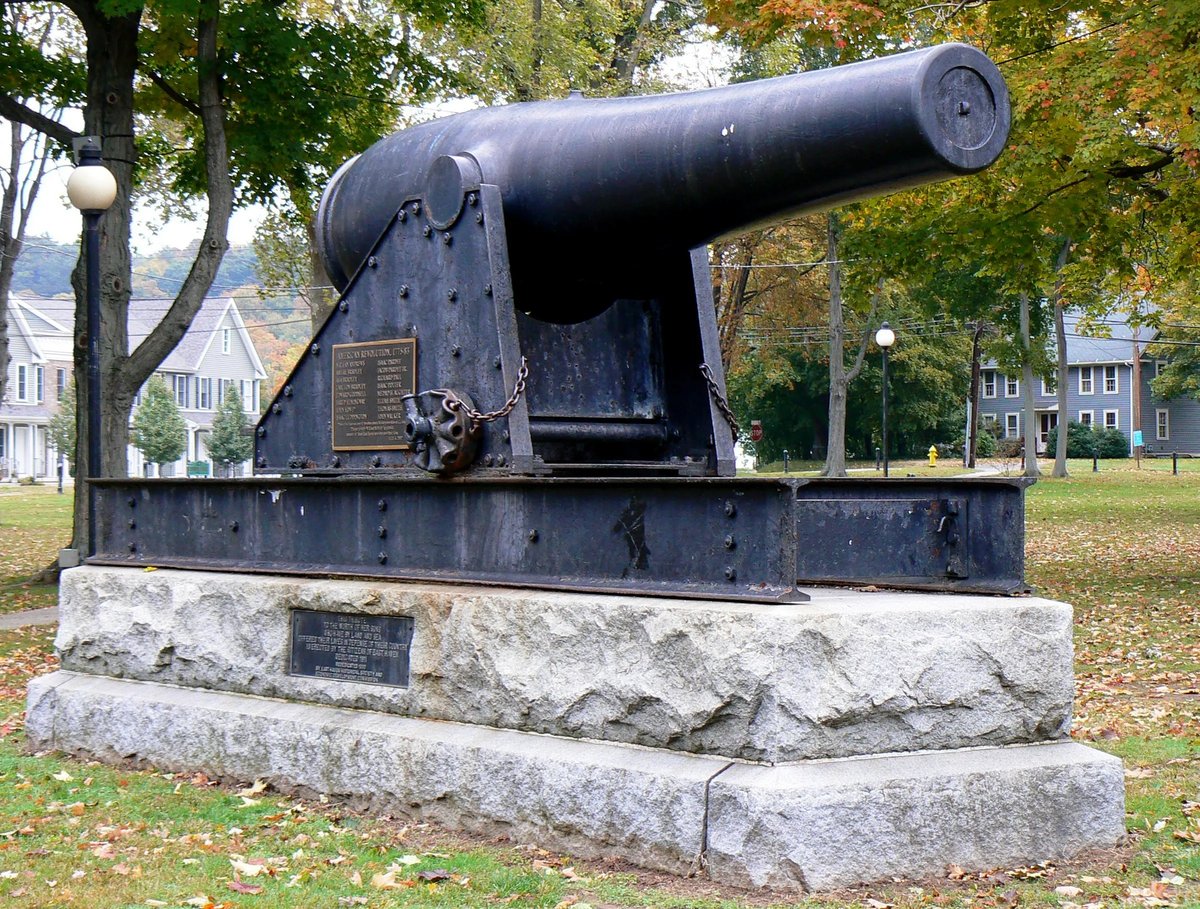

(Dave Pelland Photos)

(Dep369 Photo )
10-inch Rodman Gun, (Columbiad, 10-inch, smoothbore, seacoast, Model 1861), weight 14,980-lbs, mounted on an iron gun carriage on a concrete monument honoring Civil War and American Revolution veterans, one of several war memorials on the East Haven green.
East Haven, Fort Nathan Hale, Black Rock Fort
Fort Nathan Hale, also known as Fort Hale Park, Black Rock, is a 20-acre (8.1 ha) city park located on the east shore of New Haven Harbor. It includes the site of a 1659 fort, a Revolutionary War-era fort, and a Civil War-era fort. The fort was named after Nathan Hale, Connecticut's official hero. Since 1921, the site has been owned by the state of Connecticut. It has been used as a park and maintained as a historical site by the City of New Haven.
In early 1776, the colony of Connecticut commissioned the construction of a fort on a point of rock that stretched out into the harbor to protect the port of New Haven from the British. This was the location of an earlier unnamed fort from circa 1657, and on this site was erected Black Rock Fort. Unfortunately for the colonists, in 1779 British General William Tryon, during his raid of Connecticut coastal communities, captured Black Rock Fort along with its nineteen defenders after they had run out of ammunition. The British burned the barracks as they left. In 1807, the abandoned fort was reconstructed as Fort Nathan Hale, and it served to defend the port from the British once again during the War of 1812. In 1863, Fort Nathan Hale II was built alongside the original fort, out of concern that Southern raiders might strike the city during the Civil War, but the fort saw no battle action. This fort contained deep, earthen, bomb-proof bunkers. (Wikipedia)

(Dave Pelland Photo)
Cast-iron smoothbore muzzle-loading 6-pounder Gun, weight 12-3-4 (1,432 lbs), British broad arrow, ca 1700s, mounted on a wooden gun carriage. Black Rock Fort near Fort Hale Park.
Gilford

(Connecticut Office of Tourism Photo)
Cast-iron smoothbore muzzle-loading 4-pounder Gun mounted on a wood naval gun carriage, from the War of 1812. This gun is displayed at the 1639 Henry Whitfield House and Museum was donated in 1908.
Griswold-Jewett City

(Jerry Dougherty Photo)
M114 155-mm Howitzer.
Groton, Fort Griswold
Fort Griswold is a former military base named after then Deputy Governor Matthew Griswold. The fort played a key role in the early stages of the American Revolutionary War. In tandem with Fort Trumbull on the opposite side of the harbor, Griswold served to defend the port of New London, a supply center for the new Continental Army and a friendly port for Connecticut-sanctioned privateers who preyed on British ships.

(Author Photo, 24 Aug 2019)
Fort Griswold, view from the memorial tower.
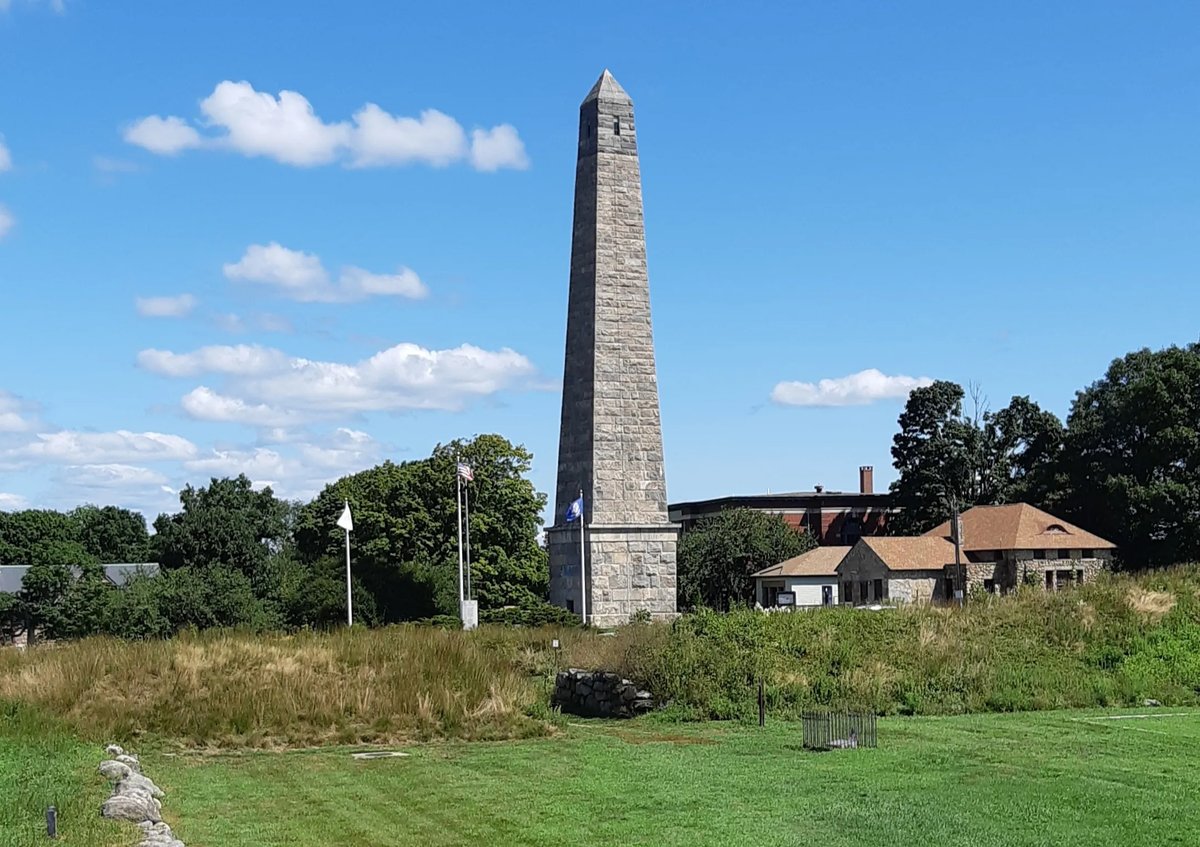
(Author Photo, 24 Aug 2019)
Fort Griswold memorial tower.
In September 1781, British troops under Benedict Arnold raided and burned New London in the Battle of Groton Heights with the objective of ending the harassment at sea. Fort Griswold had a key strategic position above the Thames River, but the British knew the fort's inner workings thanks to Arnold, who gave numerous secrets of American defences to the British forces he commanded. Arnold, knowing Griswold's layout and precise position, approached the harbour from such an angle that Griswold's gun positions could never draw an effective shot on the British fleet. Arnold's troops eventually made landfall, and the fort's garrison fought back. Artillery barrages and musket fire brought (relatively) heavy casualties to each side, the fighting continuing even past commands to stop. The British eventually captured the fort and tried to destroy it, though the plan was foiled as a patriot put out the British fire before it could reach Griswold's gunpowder stores.
The fort would be rebuilt and manned in several other conflicts, but the Battle of Groton Heights was its most prominent use. It was used during the War of 1812 by United States Navy sailors commanded by Commodore Stephen Decatur when Decatur's squadron was blockaded by a superior British force in 1814.
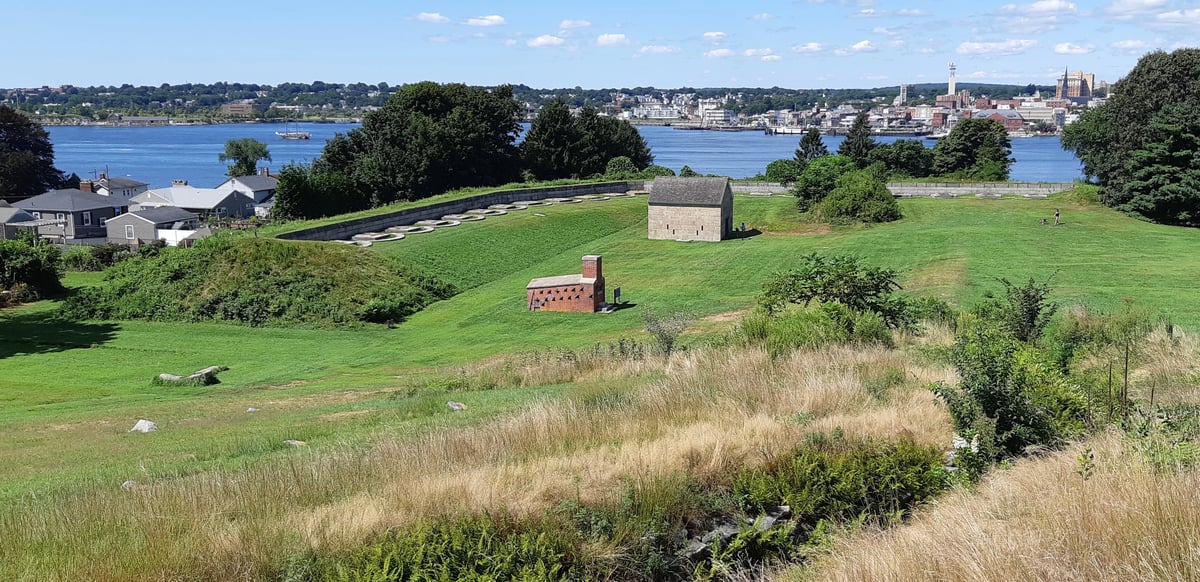
(Author Photo)
Fort Griswold.
After the American Civil War the lower battery of the fort was redesigned to mount 10-inch Rodman Guns, (Columbiad, 10-inch, smoothbore, seacoast, Model 1861). It was a sub-post of Fort Trumbull for most of its use as a fort by the U.S. Army. It was never actively garrisoned after the Civil War and was under the care of an ordnance sergeant. From 1863 to 1879 Fort Griswold was in the care of Ordnance Sergeant Mark Wentworth Smith, a Mexican War veteran. After the Spanish–American War, Fort Griswold became obsolete when Fort H.G. Wright was established on Fishers Island in Long Island Sound. (Wikipedia)

(Author Photos, 24 Aug 2019)
The wrought iron gate entrance to the fort is guarded by a pair of 32-pounder Model 1864 (6.2-inch) Dahlgren Shell Guns with Blomefield pattern breaching rings, mounted on concrete stands and flanked by stoneseats with a view of the harbour.
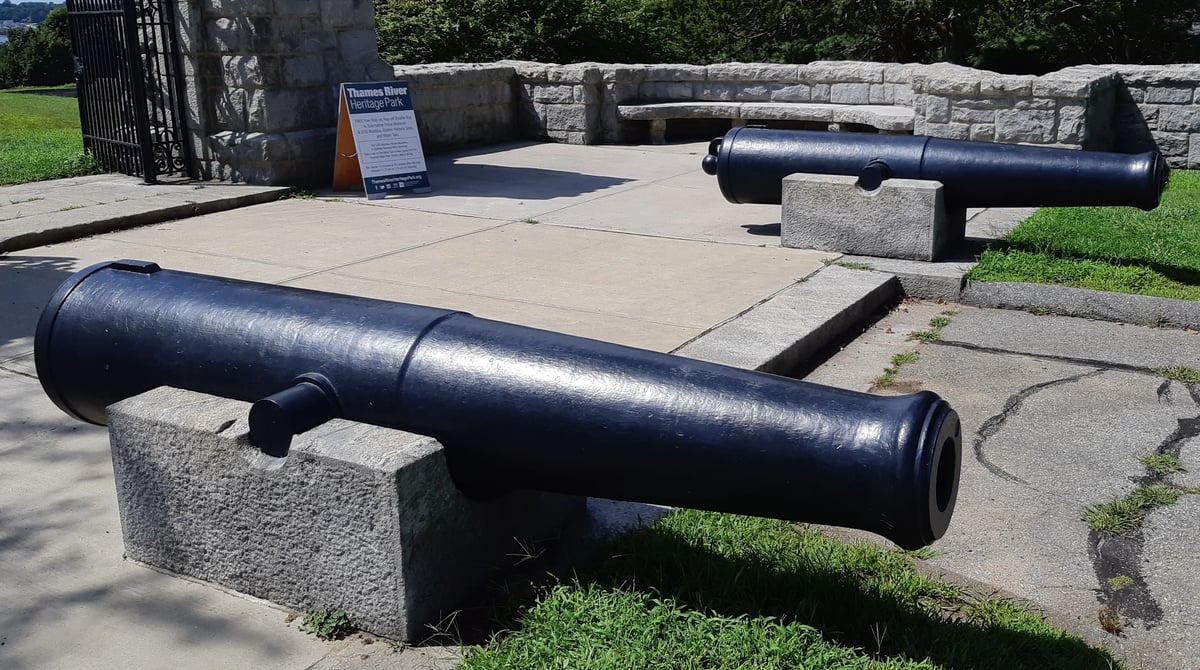


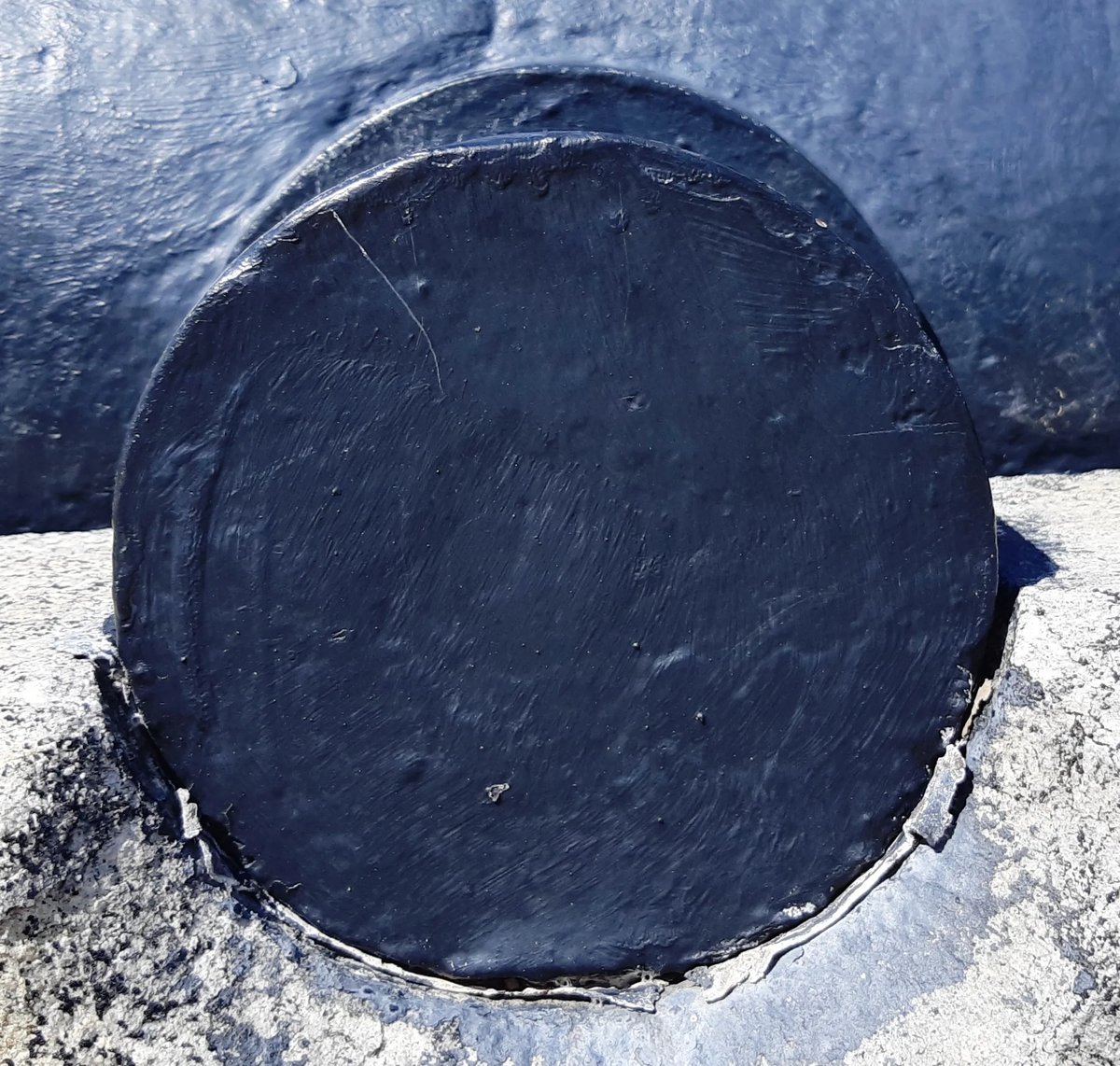
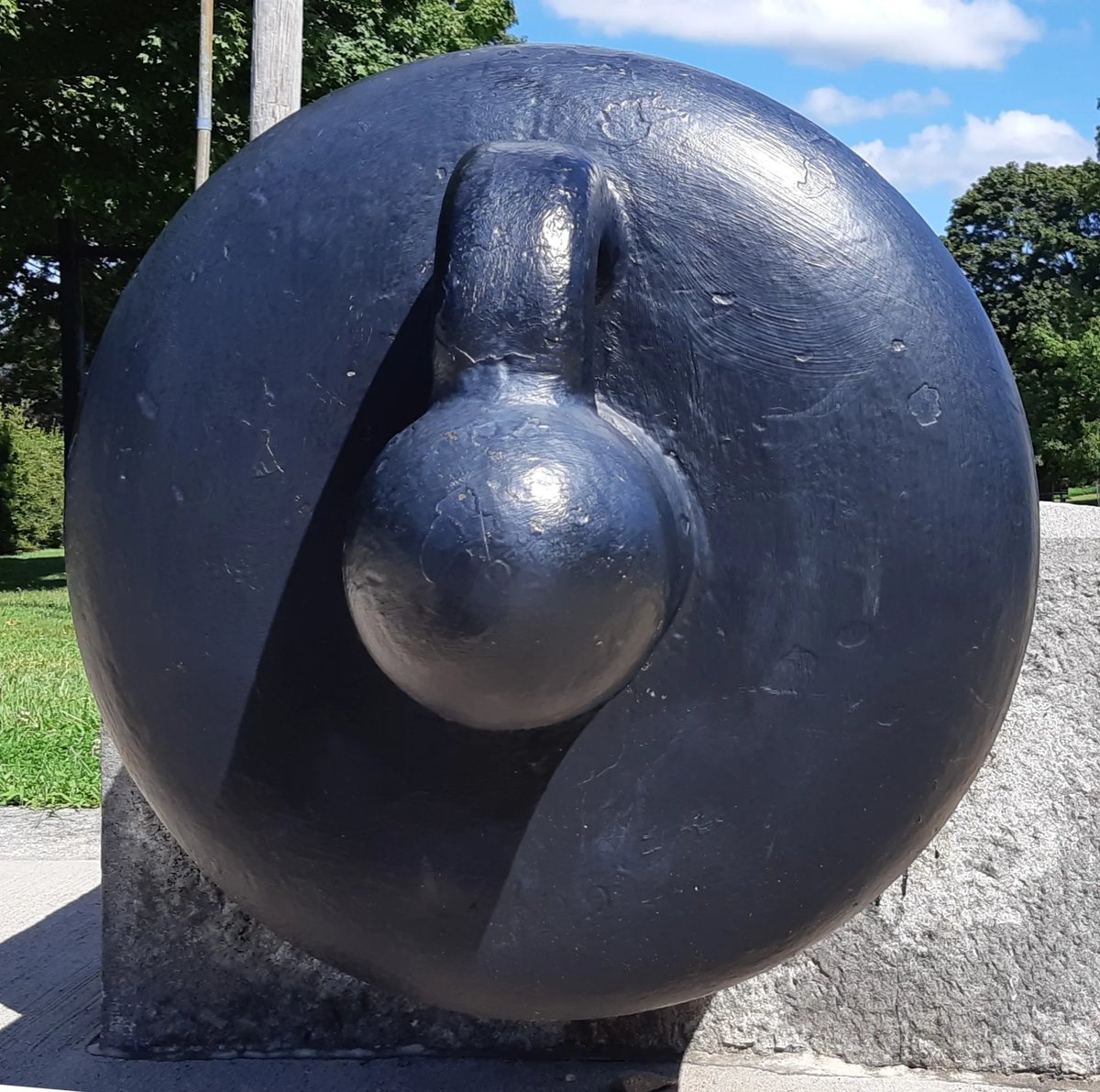
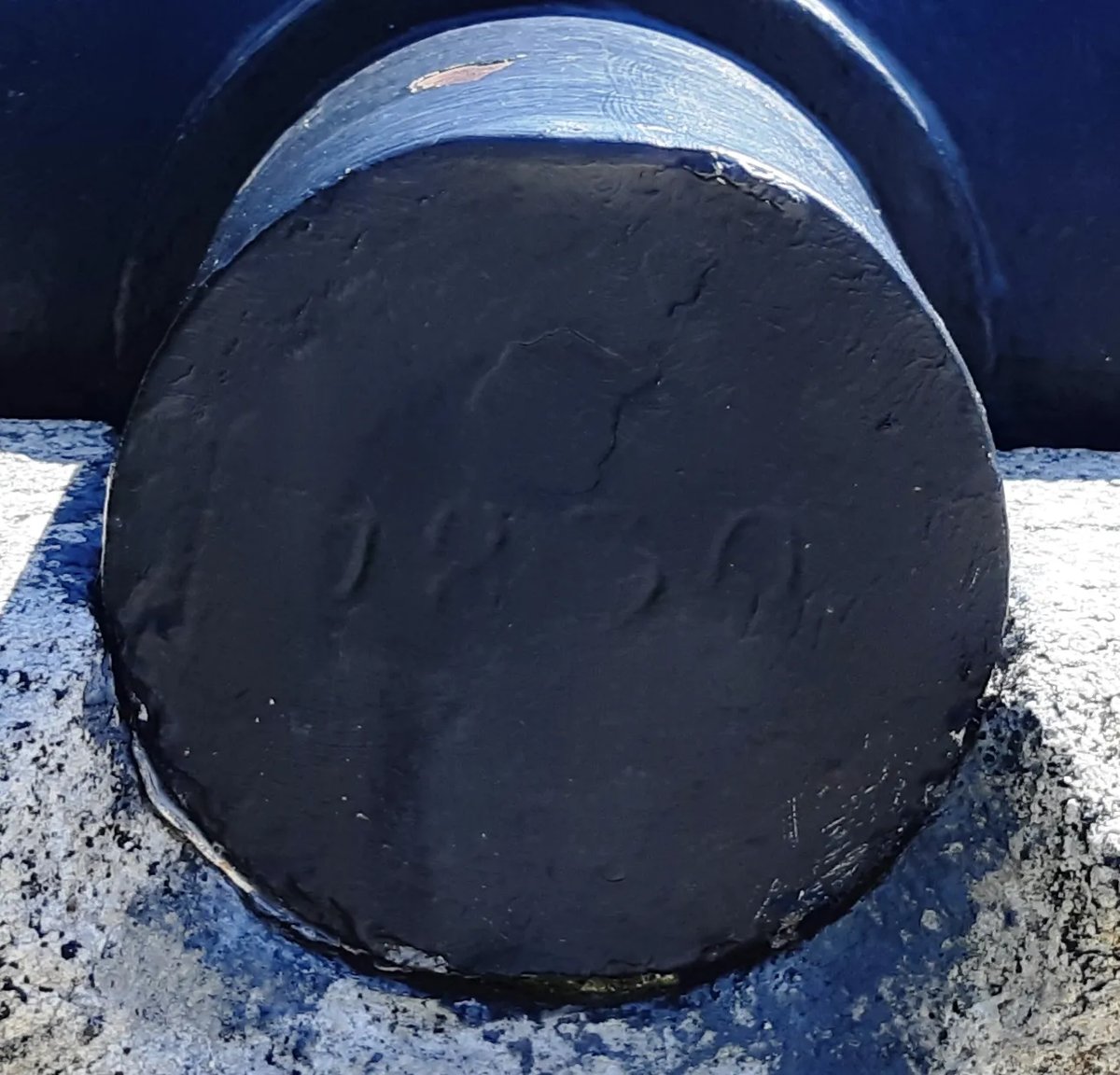
(Author Photos)
32-pounder Model 1864 (6.2-inch) Dahlgren Shell Gun, with Blomefield pattern breaching ring, 4,500 lbs, left trunnion (Serial No. 1830), No. 1 of 2.



(Author Photos)
32-pounder Model 1864 (6.2-inch) Dahlgren Shell Gun, with Blomefield pattern breaching ring, 4,500 lbs, (Serial No. painted over), No. 2 of 2.
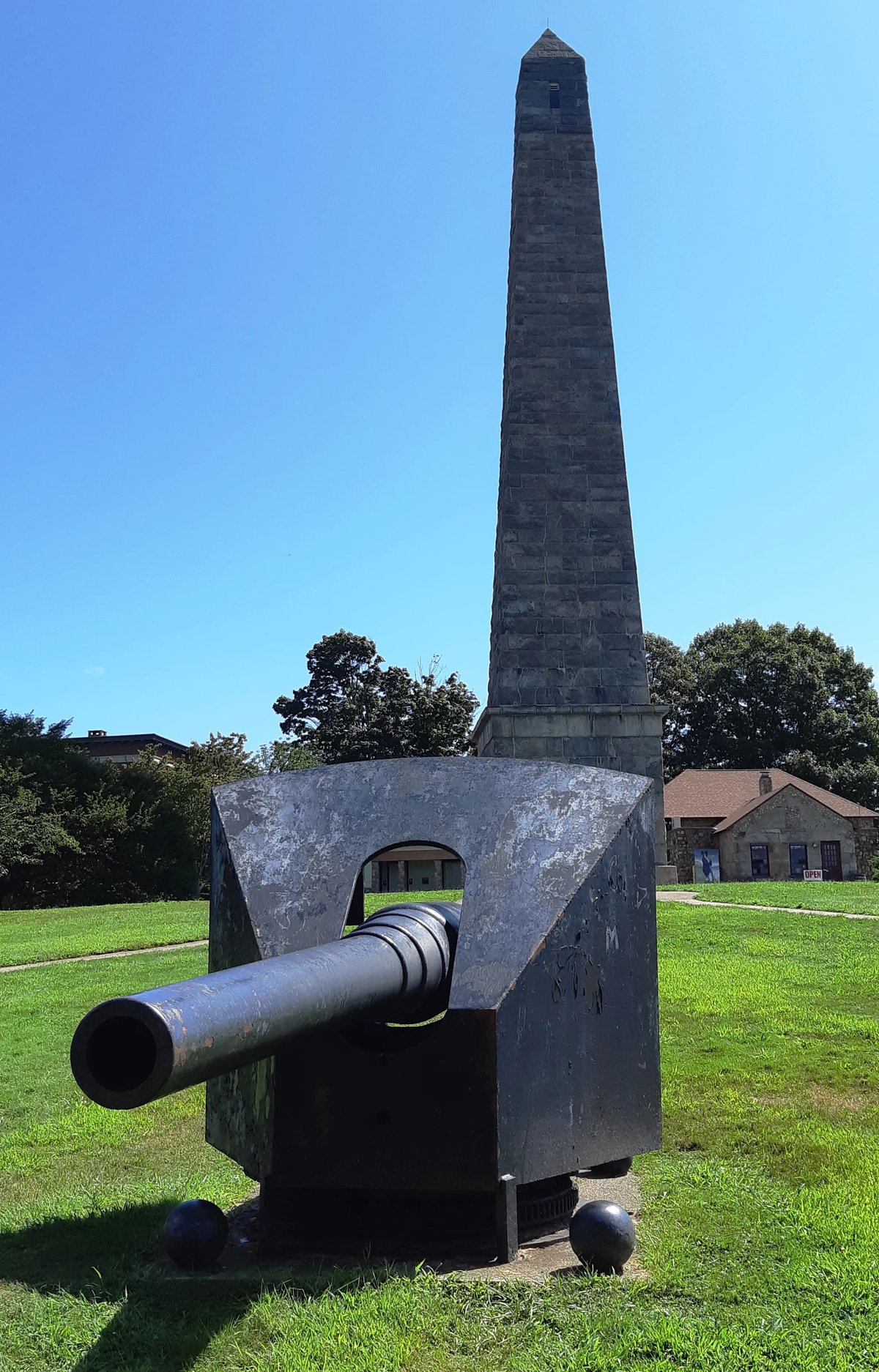
(Author Photo)
This gun is mounted in front of the Groton Monument, which was built between 1826 and 1830. It is the oldest monument of its type in the country. Built of granite quarried locally, the Monument stands 135 feet tall with 166 steps. There is a marble memorial plaque with the names of the defenders who fell during the Battle of Groton Heights on 6 September 1781. The Spanish-American War 5.7-inch gun in front of the Groton monument was taken from the Spanish flagship cruiser Infanta Maria Teresa, which took part in the Battle of Santiago, Cuba, 3 July 1898. The gun was used to fire on American ships as the Infanta Marie-Teresa tried to steam out of Cuba’s Santiago Harbor during the Spanish-American War.

(US Naval Historical Centre Photo)
Infanta Maria Teresa at São Vicente.

(Tim1965 Photo)
A pair of 28-cm (11-inch) Hontoria guns salvaged from the Spanish cruisers Infanta Maria Teresa and Vizcaya are on display in the Spanish-American War Memorial at Arlington National Cemetery in Arlington, Virginia. The monument was dedicated by President Theodore Roosevelt on 21 May 1902. The four guns are mounted on brick and concrete stands, and a pair of Spanish bronze field artillery pieces flanking the Hontoria guns.


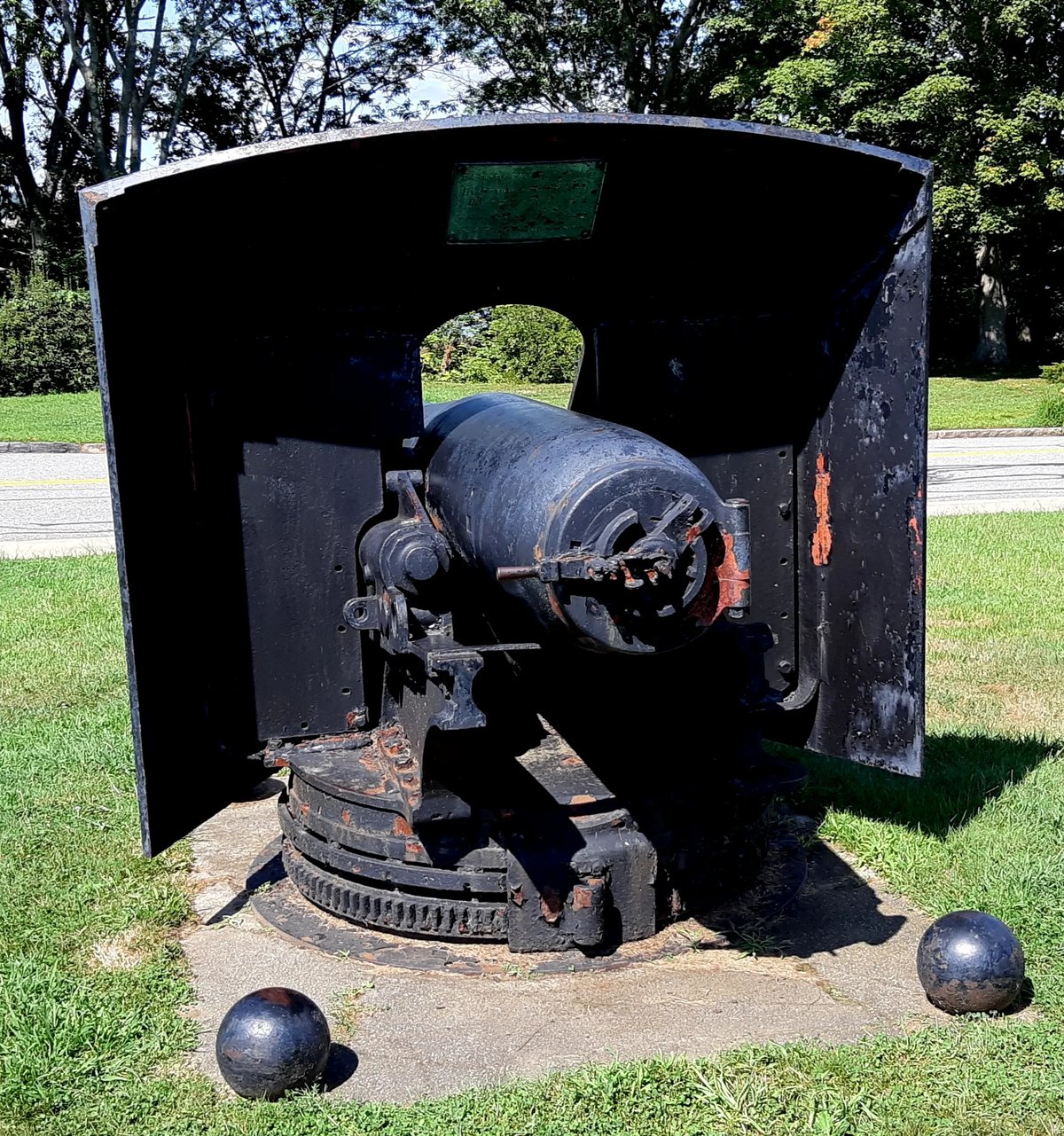




(Author Photos)
5.7-inch gun from the Spanish flagship "Infanta Maria Teresa", which took part in the Battle of Santiago, Cuba, on 3 July 1898.
Naval Submarine Base New London

(USN Photo)
USS Narwhal (SS-167), with a pair of 6-inch rifled deck guns, ca 1940.

(USN Photo)
USS Narwhal (SS-167), with a pair of 6-inch rifled deck guns, ca 1940.


(Blaise Mayers Photos)
6-inch rifle ca. 1920’s from USS Narwhal (SS-167), formerly V-5, outside Gilmore Hall, No. 1 of 2. These were the largest guns ever mounted on an American submarine. They were on board the USS Narwhal when she was berthed at Pearl Harbor during the Japanese attack on 7 December 1941.

(David Johnstone Photo)
6-inch rifle ca. 1920’s from USS Narwhal (SS-167), formerly V-5, at Morton Hall, No. 2 of 2.
Groton, United States Navy Submarine Force Library and Museum
This museum is located on the Thames River in Groton. It is the only submarine museum managed exclusively by the Naval History and Heritage Command division of the Navy, and serves as a repository for many special submarine items of national significance, including USS Nautilus (SSN-571). Visitors may take a 30-minute self-guided audio tour of the USS Nautilus.

(NARA Photo)
USS Nautilus (SSN-571) underway at sea in June 1965. USS Nautilus (SSN-571) was the world's first operational nuclear-poowered submarine and the first submarine to complete a submerged transit of the North Pole on 3 August 1958.
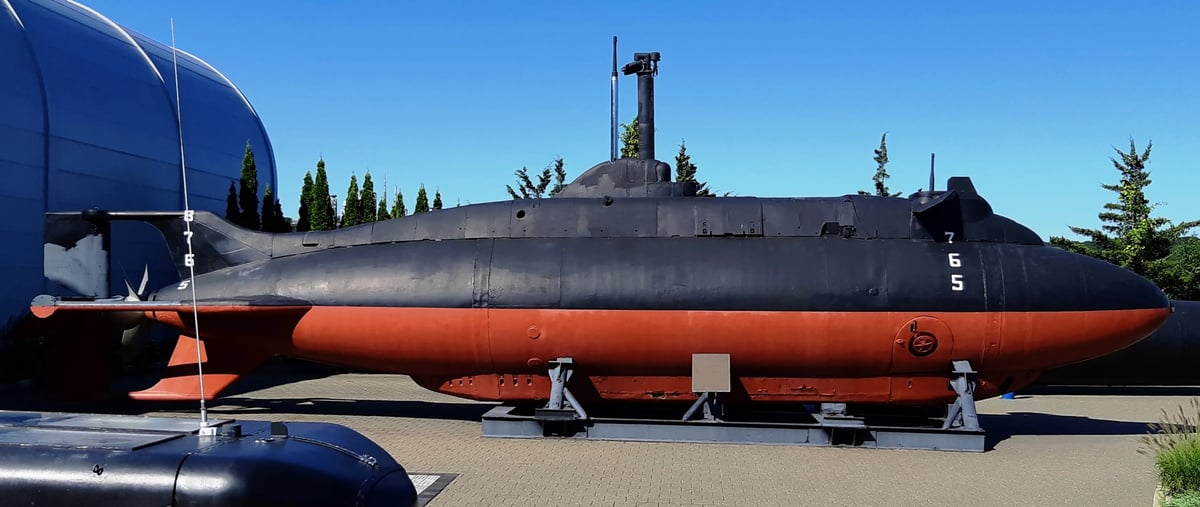
(Author Photo)
SS X-1 Midget submarine.
(Author Photo)
Japanese Type A Ko-hyoteki class submarine HA-8. Built by Karasukojima Naval Armory as the 8th Type A Midget Submarine completed. It was delivered to the Imperial Japanese Navy (IJN). At 23:08 hrs on 2 Dec 1942, IJN submarine I-20 launched HA-8 roughly 10.8 miles off Cape Esperance on Guadalcanal. The midget submarine was commanded by Lt(jg) Tanaka with crew member Mitani. On 3 Dec, the crew sighted several targets including American transports and destroyers but was briefly beached for a short time. HA-8 fired both of its torpedoes at a transport and the crew heard an explosion. Afterwards, HA-8 was chased by a destroyer but escaped without damage. When it surfaced, the midget submarine was swamped and scuttled by the crew. Both of the crew members reached the shore and joined Japanese forces on Cape Esperance. Their ultimate fate is unknown. The submarine was salvaged and came to the SUBASE Groton as part of a country war bond effort in 1943-1944 and has remained in Groton ever since. It is one of four such Type A midgets on display in the world. Source: https://www.pacificwrecks.com/subs/HA-8.html
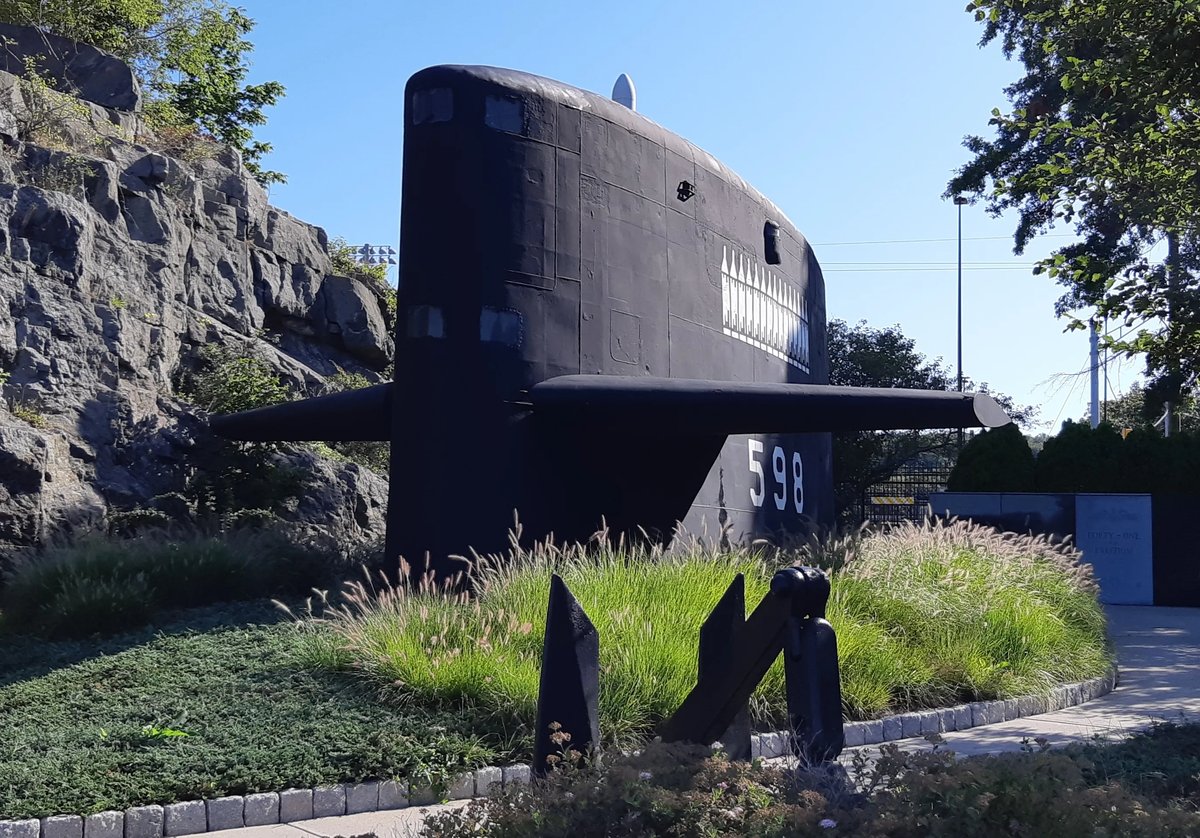
(Author Photo)
Sail section from the USS George Washington, the first nuclear powered ballistic missile submarine.
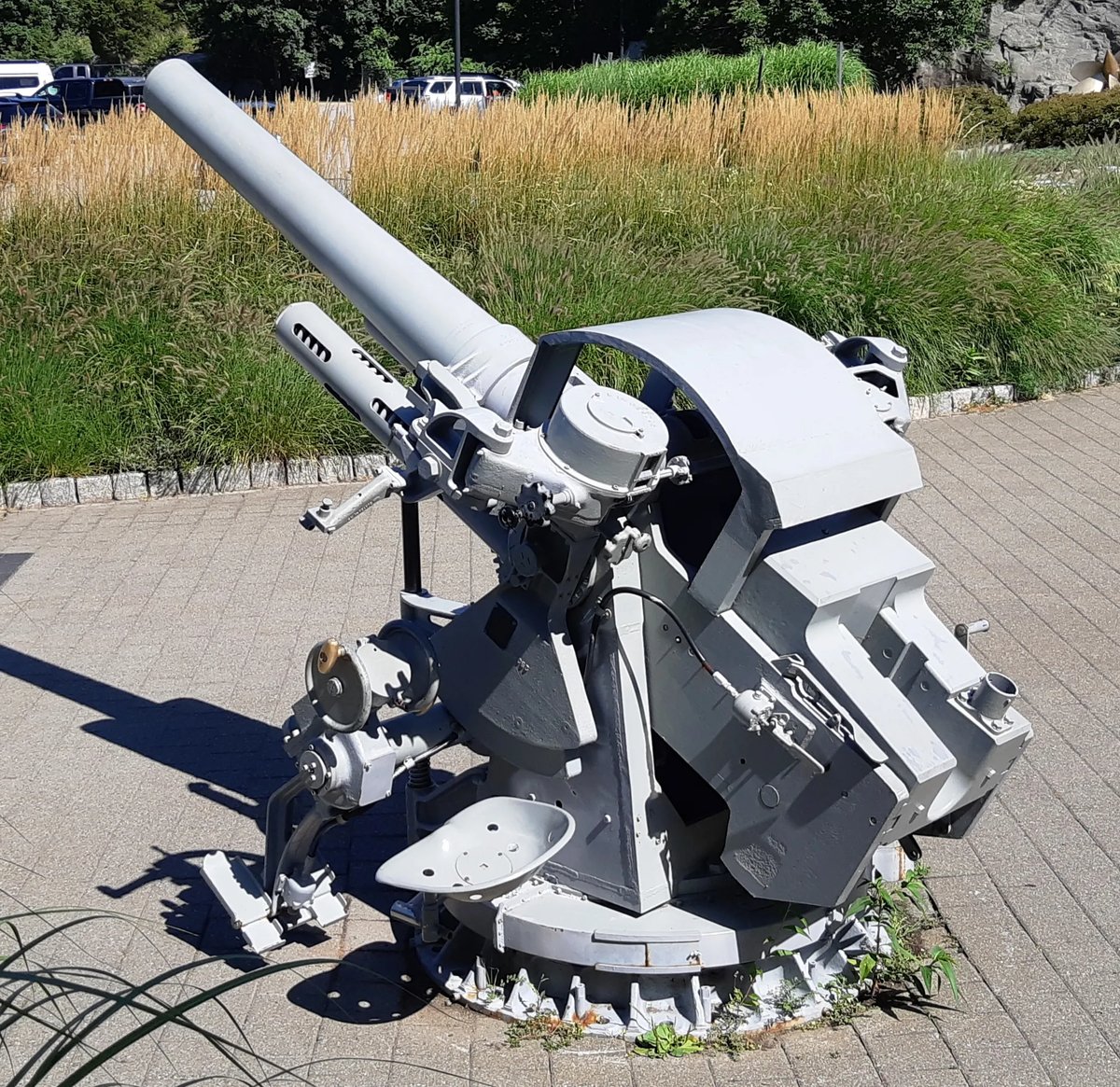
(Author Photos)
5-inch 25 calibre wet mount gun, standing in front of the museum. These guns were introduced late in the war when targets worthy of expensive torpedoes became scarce. They were difficult to build and only 270 were produced. The museum's exhibit is an original deck gun that was mounted on the deck of USS Flasher (SS-249) during the Second World War. The entire gun was made of corrosion-resistant steel so that it could withstand repeated submersion in saltwater. This model of gun came into service in 1944 and was intended to replace all earlier guns used on fleet submarines. This was the last type of deck gun ever mounted on American submarines
Possible 5-inch, 25-caliber submarine deck gun, located near the Dealy Center.
Possible 5-inch, 25-caliber submarine deck gun, located near the Navy hospital.





